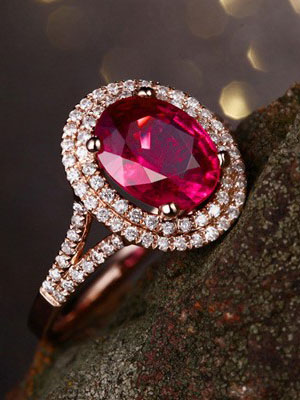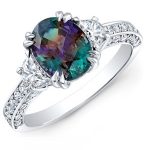
The festive Season is around the colour – and what do you think? The Colour red.
If you ask two people the difference between ruby and pink sapphire, you might get two different answers. By nature, the two stones are almost identical. Both rubies and sapphires are composed of corundum, a variety of aluminum oxide(Al2O3). The defining characteristic is color. Rubies are inherently red, and any other color is considered a sapphire. However, rubies often have pink, purple, or orange undertones. The trouble is determining the amount of undertone a red ruby can possess before it becomes known as a pink, orange or purple sapphire.
In theory, anything that isn’t classified as “red corundum” is a sapphire. In practice, this line is blurred and is hard to define because our perception of color is subjective. Remember the viral online debate of the blue/black or white/gold dress? Gemologists have an equally difficult time defining the exact moment a stone’s color slips from being defined as a ruby to being defined as a sapphire.
Since there are no exacting standards to follow, the difference between ruby and pink sapphire all depends on how color is perceived by the gem grader.
Originally, the main debate on whether pink constitutes as a ruby or a sapphire revolved around whether pink is a form of the color red. The color pink is red and white mixed together, so in essence, pink is a form of red. Would that mean that all pink corundum would also be considered red corundum? Not quite. Over time, the color pink became its own identifiable shade. But the point at which a shade transitions from being dominantly red to dominantly pink is subjective.
According to the GIA, in order for corundum to be considered a ruby, red must be the dominant hue. This means when you look at the stone, you must see more pure red than you do any other color. The lab even has a set of master stones to help determine the difference. But when examining new stones, the dominant hue is often subject to personal interpretation, which is why two equally competent graders might call the same stone either an “orangish red ruby” or a “reddish orange sapphire”.
How Chromium Impacts Ruby and Sapphire Color
Trace amounts of chromium cause a reddish color in corundum. The amount of chromium and other trace elements will determine the purity of the red shade. For instance, the more chromium present, the redder the stone will appear. Lesser amounts of chromium will make the stone more pink in nature.
The most difficult stones to access are the ones that have a mid-range amount of chromium where the color falls in between red and pink.
Other colors and undertones are produced by trace elements like iron, titanium, and vanadium.
Most Desirable Ruby Color
The most valuable ruby color is known as pigeon’s blood. It is a pure form of red with no discernible undertones. Burmese rubies are considered this type of red and are often marked as being the highest quality.
Easily Identifiable Pink Sapphire Tones
Not all pink sapphires run the gauntlet when being graded because some shades of pink are quite different than most rubies. For instance, there is a treated shade of hot pink sapphire on the market that has no resemblance to a red ruby. Also, some lab created and natural pink sapphires are light enough to be easily categorized.
Next time you’re on the fence about whether your stone is a ruby or a sapphire, remember that if it’s another definable color like light pink or bright orange, it’s most definitely a sapphire. If it’s hard to tell whether the stone is more red than pink or more red than orange, your guess is as good as mine. When in doubt, send off for a certification, but even then know that the result on borderline stones is subjective. Your best bet if you can afford it is to buy a natural, untreated stone in a color you like — regardless of what it’s called.



